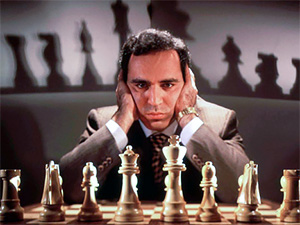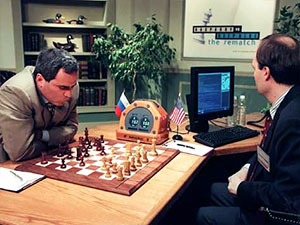


Nearly two decades later, the match still fascinates
This week Time Magazine ran a story on the famous series of matches between IBM's supercomputer and Garry Kasparov. The subject was a few of the moves that stood out for a variety of reasons, such as a bug in game one of the 1997 match, and a move in game two that Kasparov found so unbelievable that he accused the Deep Blue team of cheating. The allegation was that a grandmaster, presumably a top rival, had been behind the move.
In fact, grandmaster Yasser Seirawan told Wired in 2001, “It was an incredibly refined move,
of defending while ahead to cut out any hint of countermoves, and it sent Garry into a tizzy.”
The topic of analyzing some key moves by Deep Blue with a top engine was recently covered at ChessBase News in a series of three articles:
 |
Komodo 8: Deep Blue revisited (part one)12/26/2014 – When Garry Kasparov faced IBM's super computer Deep Blue, there was not a player alive who did not secretly dream of having their own private Deep Blue to consult on demand. That day has already come and passed as today's engines such as Komodo 8 can outperform the famous computer even on a smartphone. Here we take a look at the famous match and key moments. |
 |
Komodo 8: Deep Blue revisited (part two)12/31/2014 – The first two games of the titanic match between the world's strongest player versus the world strongest chess computer showed significant changes. While the computer played moves that baffled humans, the number of moves a grandmaster would outright scoff at were dwindling and could only be judged as eccentric. Today's best engines are actually no different, just stronger. |
 |
Komodo 8: Deep Blue revisited (part three)1/9/2015 – Nearly eighteen years later, the matches between Garry Kasparov and Deep Blue continue to stir the imagination and fascination of people around the world. It has inspired books, documentaries, and theatrical productions. Looking over the games with a top engine such as Komodo 8, and comparing with the computer logs, sheds new light, and even reveals a missed win by Kasparov. |
However, the purpose had been to highlight refinements and revelations uncovered with modern hardware and chess engines, and since there had been no disagreement with the so-called cheating move, it was not mentioned. So the engines agree with Deep Blue's choice, is that all? Not quite. Let's take a look at the controversial moment first.

This was the position on the board after 35 moves. It is White to play.
Before trying to simply guess what was played, if you don't already know, it is important to remember that the year is 1997, and engines, and even supercomputers, played quite a bit differently than today's uber-engines. They were notoriously materialistic, and a tactic used by a player such as Kasparov, who would get deep into the head of his opponent, was to bait the machine with a 'poisoned pawn', allowing him to direct the game in a direction of his choosing.
The pawn on b5 is clearly weak, and it should not be hard to bring it crashing down. The problem is that the most direct method is far less than optimal. As noted by grandmaster John Nunn, who annotated the game then and whose notes can be found among the tens of thousands of commented games in MegaDatabase:

Needless to say, Deep Blue did not follow the trail of bread crumbs Kasparov was carefully sprinkling in its path. It played the very strong 36.axb5! axb5 and 37.Be4! to which Nunn comments, " A cruel move. Black's only chance of counterplay is to activate his bishop by ...e4, but Deep Blue cuts the rope which might have saved the drowning Kasparov."
In fact, if you consult any of the top engines of today, whether it be Houdini 4, Stockfish 6, or Komodo 8, they all choose Deep Blue's move 36.axb5. For example:
Komodo 8: 36.axb5 axb5 37.Be4 Qd8 38.Kh2 Rcb8 39.Ra6 Kf8 40.R6a5 Kg8 41.R1a2 Rxa5 42.Rxa5 Bc7 43.Ra1 Bb6
+/- (0.84) Depth: 29 00:02:15 686MN, tb=57
The problem is that it does not condemn 36.Qb6 either, just the blind pawngrabbing that follows. That very same Be4 can be combined with it to great effect. So what does this all mean? It means that while 36.axb5 was indeed a very strong move, it was not the only one, and the move order was not actually essential so long as the ideas are maintained, and, as pointed out by Nunn, White avoids allowing Black the time to strike back with ...e4 himself.
Analysis with the top engine lines:

It is clear that while Deep Blue was far ahead of its time, by the time the controversial position arrived, it had more than one path to victory.
If you are seeking the best today, in the most advanced interface available, including a Premium subscription to Playchess, then Komodo 8 is the way to go.

Minimum: Pentium III 1 GHz, 2 GB RAM, Windows Vista, XP (Service Pack 3), 7/8, DirectX9, 256 MB graphics card, DVD-ROM drive, Windows Media Player 9 and Internet access for program activation, access to Playchess.com, Let’s Check and program updates.
Recommended: PC Intel i7 (Quadcore), 4 GB RAM, Windows 8.1, DirectX10, 512 MB graphics card, 100% DirectX10-compatible sound card, Windows Media Player 11, DVD-ROM drive and Internet access for program activation, access to Playchess.com, Let's Check and program updates.
Price: €79.90 (€67.14 without VAT for customers outside the EU; $86.62 without VAT). Languages: English, German. ISBN: 978-3-86681-442-4; EAN: 9783866814424. Delivery: Download, Post
| Advertising |